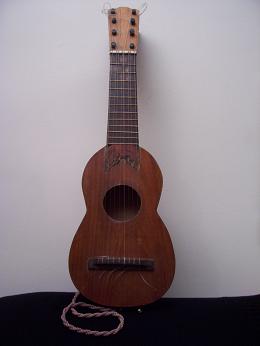
Jarana
Encyclopedia

Guitar
The guitar is a plucked string instrument, usually played with fingers or a pick. The guitar consists of a body with a rigid neck to which the strings, generally six in number, are attached. Guitars are traditionally constructed of various woods and strung with animal gut or, more recently, with...
-shaped fretted
Fret
A fret is a raised portion on the neck of a stringed instrument, that extends generally across the full width of the neck. On most modern western instruments, frets are metal strips inserted into the fingerboard...
stringed instrument, from the southern region of the state of Veracruz
Veracruz
Veracruz, formally Veracruz de Ignacio de la Llave officially Estado Libre y Soberano de Veracruz de Ignacio de la Llave , is one of the 31 states that, along with the Federal District, comprise the 32 federative entities of Mexico. It is divided in 212 municipalities and its capital city is...
, Mexico
Mexico
The United Mexican States , commonly known as Mexico , is a federal constitutional republic in North America. It is bordered on the north by the United States; on the south and west by the Pacific Ocean; on the southeast by Guatemala, Belize, and the Caribbean Sea; and on the east by the Gulf of...
. Typically strung with 8 strings in 5 courses, usually arranged in two single outer strings with three courses between. The strings are usually nylon, although they were gut in the past. The body is somewhat narrower in proportion to a guitar; this is due to its direct lineage from the Spanish baroque guitar of the sixteenth century. Sometimes mistaken for a ukulele
Ukulele
The ukulele, ; from ; it is a subset of the guitar family of instruments, generally with four nylon or gut strings or four courses of strings....
, the jarana jarocha comes in at least four sizes, the smallest being the 'mosquito or chaquiste', about the size of a soprano ukulele; the 'primera', about the size of a concert ukulele; the 'segunda', in length between a tenor and a baritone ukulele; and the 'tercera', which is somewhat longer than the baritone ukulele.
The jarana traditionally features a very singular type of construction; the body is carved to shape from a solid piece of wood (traditionally Spanish cedar) and it is then hollowed out, with a separate soundboard and fingerboard applied. Other Mexican and South American folk guitars derivative of Spanish instruments are also made this way, notably the charango
Charango
The charango is a small Andean stringed instrument of the lute family, 66 cm long, traditionally made with the shell of the back of an armadillo. Primarily played in traditional Andean music, and is sometimes used by other Latin American musicians. Many contemporary charangos are now made with...
of Bolivia.
The sound is distinctive--it does not sound like either a ukulele or a guitar. It is almost a percussion instrument in the way it is played, with an accented down and double upstroke pattern which almost mimics the zapateado
Zapateado
The zapateado is a dance of Mexican Indian origin characterized by a lively rhythm punctuated by the striking of the dancer's shoes, akin to tap dance...
steps of the dancers. The sound depends on the wood used and the size of the instrument. Jaranas by different makers tend to have different voices even when made of the same woods, due to method of manufacture, etc.
The jarana primera tends to have a high and sharp voice, while the segunda has a more tenor, shimmering voice. The tercera has a deep and sonorous voice, and the tiny mosquito has an often shrill voice.
The jarana is used to great effect in combination with other instruments such as the 'arpa jarocha' or Veracruz folk harp, the 'guitarra de son' which is almost identical to the jarana but for the fact that it has four strings which are plucked with a long plectrum usually made of cowhorn (thus making it a melodic rather than rhythm instrument) as well as being used as a lead instrument in vocal music.

